A Zonal Approach for Wide-Area Temporary Voltage Quality Assessment in a Smart Grid
Abstract
:1. Introduction
1.1. Motivation and Incitement
1.2. Literature Review
1.3. Contribution and Paper Organization
2. Wide-Area Voltage Quality in Distribution Networks
2.1. Voltage Quality Metrics Suitable for Wide-Area Monitoring
2.2. Advanced Metering Infrastructure Enabling Wide-Area Power Quality Measurements
2.3. Real-World Case Studies of Power Quality Monitoring Systems in Distribution Networks
2.4. Temporary Voltage Quality Concept
3. A Zonal Approach for Wide-Area Temporary Voltage Quality Assessment
3.1. Distribution Network Division into Voltage Quality Zones
3.2. A Decision Support System for the Rating of Temporary Voltage Quality Zones
3.3. VQ Zone Rating Conditions and Different Load Types
4. Distribution Smart Grid Model
4.1. Distribution Network Elements, Topology, and Configuration
4.2. Determination of VQ Zones
5. Simulation Case Studies and Results
5.1. Distribution Network Operation—A Base Case
5.2. Loads with Low Power Factors
5.3. Manual Voltage Regulation at MV2/LV Transformers
5.4. Unbalanced Loads
5.5. Integration of Solar Power Plant
5.6. Nonlinear Loads
- Six-pulse voltage-source adjustable speed drive (ASD)
- Data center-personal computer (PC)
- Residential air conditioner (RAC)
- Fluorescent lighting-magnetic ballast (FL-MB)
- Fluorescent lighting-electronic ballast (FL-EB)
6. Cybersecurity Challenges
6.1. Security Vulnerabilities
6.2. Data Privacy
6.3. Resilience to Cyber Threats
7. Discussions and Future Research
Future Research Focusing on Field Trials
- Assess the level of DN observability, i.e., the number of nodes within the DN equipped with devices capable of monitoring PQ.
- Evaluate the suitability of existing AMI for supporting online VQ monitoring and temporary VQ assessment (using 10 min-based VQ ratings).
- Based on the DN observability level and AMI capabilities, segment the observable part of the DN into corresponding VQ zones.
- Customize the proposed DSS for temporary VQ assessment by adjusting the rules and thresholds for standardized VQ indices, if necessary.
- Validate the customized DSS and refine the rules and thresholds if any issues are identified following the implementation of control or protection actions.
8. Conclusions
9. Publication Statement
Author Contributions
Funding
Data Availability Statement
Conflicts of Interest
References
- Jabr, R.A.; Dzafic, I. Distribution Management Systems for Smart Grid: Architecture, Work Flows, and Interoperability. J. Mod. Power Syst. Clean Energy 2022, 10, 300–308. [Google Scholar] [CrossRef]
- Bollen, M. What is power quality? Electr. Power Syst. Res. 2003, 66, 5–14. [Google Scholar] [CrossRef]
- Bollen, M.; Castel, R.; Friedl, W.; Villa, F.; Baumann, P.; Esteves, J.; Larzeni, S.; Ström, L.; Beyer, Y.; Faias, S.; et al. Guidelines for good practice on voltage quality monitoring. In Proceedings of the 22nd International Conference and Exhibition on Electricity Distribution (CIRED 2013), Stockholm, Switzerland, 10–13 June 2013; pp. 1–4. [Google Scholar]
- European Norm EN 50160; Voltage Characteristics of Electricity Supplied by Public Distribution Systems. CENELEC: Brussels, Belgium, 2010.
- IEC 61000-3-6:2008; Electromagnetic Compatibility (EMC)–Part 3-6: Limits—Assessment of Emission Limits for the Connection of Distorting Installations to MV, HV and EHV Power Systems. IEC: Geneva, Stockholm, 2008.
- IEEE Std 1159-2019 (Revision of IEEE Std 1159-2009); IEEE Recommended Practice for Monitoring Electric Power Quality. IEEE: Piscataway, NJ, USA, 2019; pp. 1–98.
- Remigio-Carmona, P.; Rosa, J.J.G.-D.-L.; Florencias-Oliveros, O.; Sierra-Fernández, J.M.; Fernández-Morales, J.; Espinosa-Gavira, M.J.; Agüera-é, A.; Palomares-Salas, J.-C. Current Status and Future Trends of Power Quality Analysis. Energies 2022, 15, 2328. [Google Scholar] [CrossRef]
- Gupta, A. Power quality evaluation of photovoltaic grid interfaced cascaded h-bridge nine-level multilevel inverter systems using d-statcom and upqc. Energy 2022, 238, 121707. [Google Scholar] [CrossRef]
- Mahela, O.P.; Khan, B.; Alhelou, H.H.; Siano, P. Power Quality Assessment and Event Detection in Distribution Network with Wind Energy Penetration Using Stockwell Transform and Fuzzy Clustering. IEEE Trans. Ind. Inform. 2020, 16, 6922–6932. [Google Scholar] [CrossRef]
- Chen, C.I.; Chen, Y.C.; Chin, Y.C.; Chen, C.H. Integrated power-quality monitoring mechanism for microgrid. IEEE Trans. Smart Grid 2018, 9, 6877–6885. [Google Scholar] [CrossRef]
- Milanovié, J.V.; Meyer, J.; Ball, R.F.; Howe, W.; Preece, R.; Bollen, M.H.J.; Elphick, S.; Čukalevski, N. International industry practice on power-quality monitoring. IEEE Trans. Power Deliv. 2014, 29, 934–941. [Google Scholar] [CrossRef]
- Bollen, M.; Milanovié, J.V.; Čukalevski, N. CIGRE/CIRED JWG C4.112—Power Quality Monitoring. In Proceedings of the International Conference on Renewable Energies and Power Quality (ICREPQ’14), Cordoba, Spain, 7–10 April 2014. [Google Scholar]
- Bollen, M.; Bahramirad, S.; Khodaei, A. Is there a place for power quality in the smart grid? In Proceedings of the 2014 16th International Conference on Harmonics and Quality of Power (ICHQP), Bucharest, Romania, 25–28 May 2014; pp. 713–717. [Google Scholar]
- Luo, A.; Xu, Q.; Ma, F.; Chen, Y. Overview of power quality analysis and control technology for the smart grid. J. Mod. Power Syst. Clean Energy 2016, 4, 1–9. [Google Scholar] [CrossRef]
- Jain, A.; Bhullar, S. Online management and assessment of power quality issues through smart metering in smart grid architecture. Energy Rep. 2022, 8, 613–631. [Google Scholar] [CrossRef]
- Elphick, S.; Ciufo, P.; Drury, G.; Smith, V.; Perera, S.; Gosbell, V. Large scale proactive power-quality monitoring: An example from Australia. IEEE Trans. Power Deliv. 2017, 32, 881–889. [Google Scholar] [CrossRef]
- Carvalho, E.L.N.; Passos, F.O.; Cyrillo, I.O.; Miranda, J.; Filho, J.M.C.; Carneiro, J.R.; Motta, L.J.; de Costa, M.V.; Pereira, N.B.; Silveira, P.M.; et al. A proposal for power quality management system. In Proceedings of the 2020 19th International Conference on Harmonics and Quality of Power (ICHQP), Naples, Italy, 29 May–1 June 2022; pp. 1–6. [Google Scholar]
- Montano, J.C.; Bravo, J.C.; Borras, D.; Castilla, M.; Lopez, A.; Gutierrez, J. Voltage quality index. In Proceedings of the International Symposium on Power Electronics, Electrical Drives, Automation and Motion, 2006. (SPEEDAM 2006), Taormina, Italy, 23–26 May 2006; pp. 814–817. [Google Scholar]
- Elbasuony, G.S.; Aleem, S.H.A.; Ibrahim, A.M.; Sharaf, A.M. A unified index for power quality evaluation in distributed generation systems. Energy 2018, 149, 607–622. [Google Scholar] [CrossRef]
- Western Power Distribution. Primary Networks Power Quality Analysis. Six Monthly Project Progress Reports, 2018–2021. Available online: https://www.nationalgrid.co.uk/projects/primary-networks-power-quality-analysis-pnpqa (accessed on 7 May 2024).
- Music, M.; Bosovic, A.; Hasanspahic, N.; Avdakovic, S.; Becirovic, E. Integrated Power Quality Monitoring Systems in smart distribution grids. In Proceedings of the 2012 IEEE International Energy Conference and Exhibition (ENERGYCON), Florence, Italy, 9–12 September 2012; pp. 501–506. [Google Scholar]
- Rahman, F.A. System-wide power quality monitoring in Malaysia. In Proceedings of the CIRED 2005—18th International Conference and Exhibition on Electricity Distribution, Turin, Italy, 6–9 June 2005; pp. 1–5. [Google Scholar]
- Sabin, D.D.; Dimitriu, C.; Doherty, F.; Santiago, D. System-wide power quality monitoring at the consolidated Edison company of New York. In Proceedings of the 2012 IEEE 15th International Conference on Harmonics and Quality of Power, Hong Kong, China, 17–20 June 2012; pp. 870–875. [Google Scholar]
- MATLAB; (R2020b); The MathWorks Inc.: Natick, MA, USA, 2020.
- Horowitz, K.; Peterson, Z.; Coddington, M.; Ding, F.; Sigrin, B.; Saleem, D.; Baldwin, S.E.; Lydic, B.; Stanfield, S.C.; Enbar, N.; et al. An Overview of Distributed Energy Resource (DER) Interconnection: Current Practices and Emerging Solutions; Technical Report NREL/TP-6A20-72102; National Renewable Energy Laboratory: Golden, CO, USA, 2019.
- Islam, H.; Mekhilef, S.; Shah, N.B.M.; Soon, T.K.; Seyedmahmousian, M.; Horan, B.; Stojcevski, A. Performance evaluation of maximum power point tracking approaches and photovoltaic systems. Energies 2018, 11, 365. [Google Scholar] [CrossRef]
- Grady, M. Understanding Power System Harmonics. 2012. Available online: https://web.ecs.baylor.edu/faculty/grady/understanding_power_system_harmonics_grady_april_2012.pdf (accessed on 6 June 2019).
- Yan, Y.; Hu, R.Q.; Das, S.K.; Sharif, H.; Qian, Y. An efficient security protocol for advanced metering infrastructure in smart grid. IEEE Netw. 2013, 27, 64–71. [Google Scholar] [CrossRef]
- Ye, F.; Qian, Y.; Hu, R.Q. A security protocol for advanced metering infrastructure in smart grid. In Proceedings of the 2014 IEEE Global Communications Conference, Austin, TX, USA, 8–12 December 2014; pp. 649–654. [Google Scholar]
- Hansen, A.; Staggs, J.; Shenoi, S. Security analysis of an advanced metering infrastructure. Int. J. Crit. Infrastruct. Prot. 2017, 18, 3–19. [Google Scholar] [CrossRef]
- Abdullah, A.A.; El-den, B.M.; Abo-Al-Ez, K.M.; Hassan, T.M. Security Management for an Advanced Metering Infrastructure (AMI) System of Smart Electrical Grids. Appl. Sci. 2023, 13, 8990. [Google Scholar] [CrossRef]
- Simović, A.; Jokić, S.; Lemez, A.; Stojković, Z. An improved experimental power distribution system simulator for the analysis of power quality parameters. In Proceedings of the 2023 22nd International Symposium INFOTEH-JAHORINA (INFOTEH), East Sarajevo, Bosnia and Herzegovina, 15–17 March 2023; pp. 1–5. [Google Scholar]
- Simović, A.; Lemez, A.; Stojković, Z.; Bošković, M.; Jokić, S. An Analysis of the Application of the “VROT-18 System” for Increasing the Power Quality and Energy Efficiency of the Low-voltage Distribution Network. In Proceedings of the 2023 17th International Conference on Engineering of Modern Electric Systems (EMES), Oradea, Romania, 9–10 June 2023; pp. 1–4. [Google Scholar]
- Forcan, M.; Simović, A.; Jokić, S.; Forcan, J. A Zonal Approach for Wide Area Temporary Voltage Quality Assessment in Smart Grid. Available online: https://ssrn.com/abstract=4427987 (accessed on 7 May 2024).
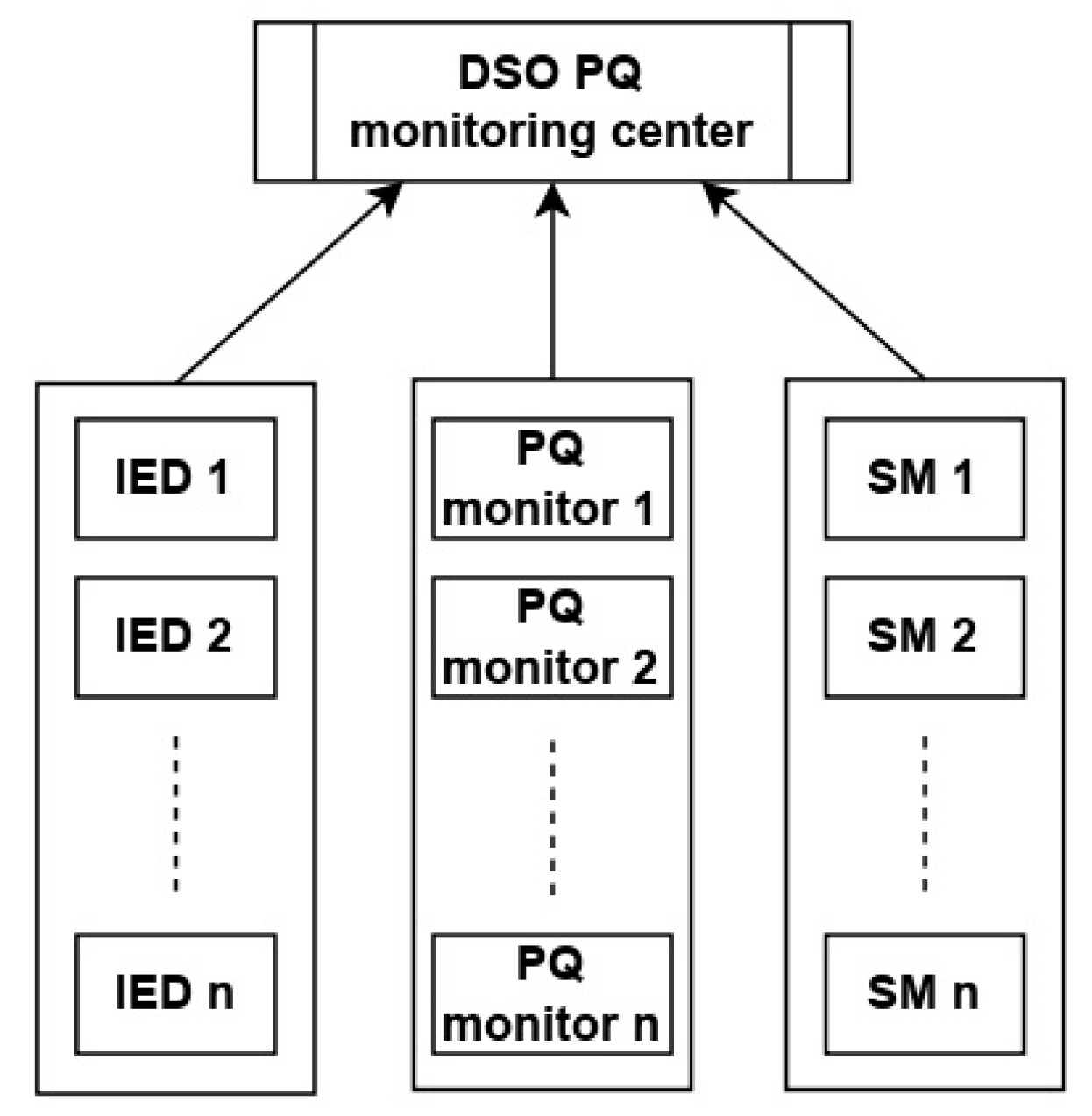

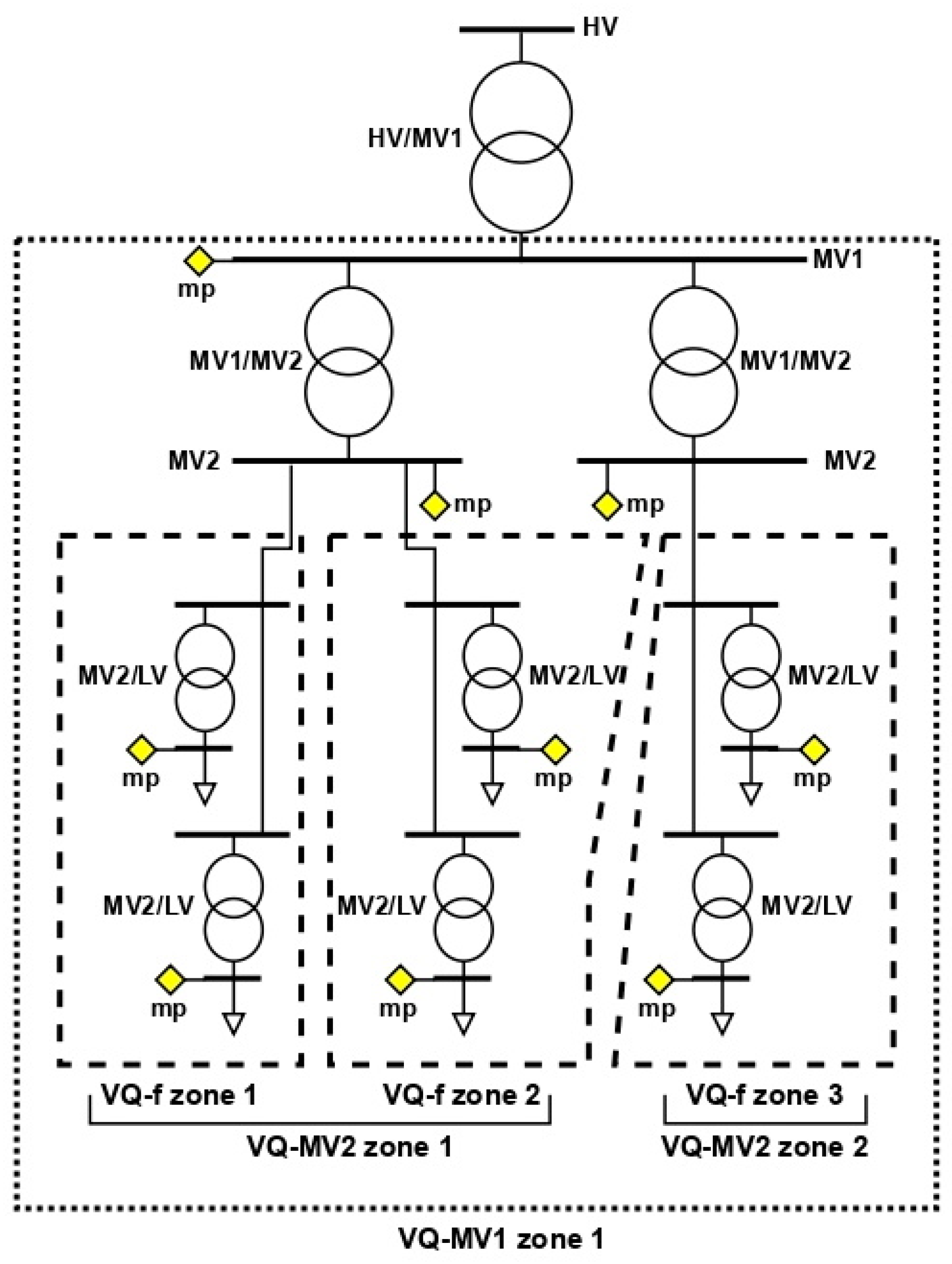

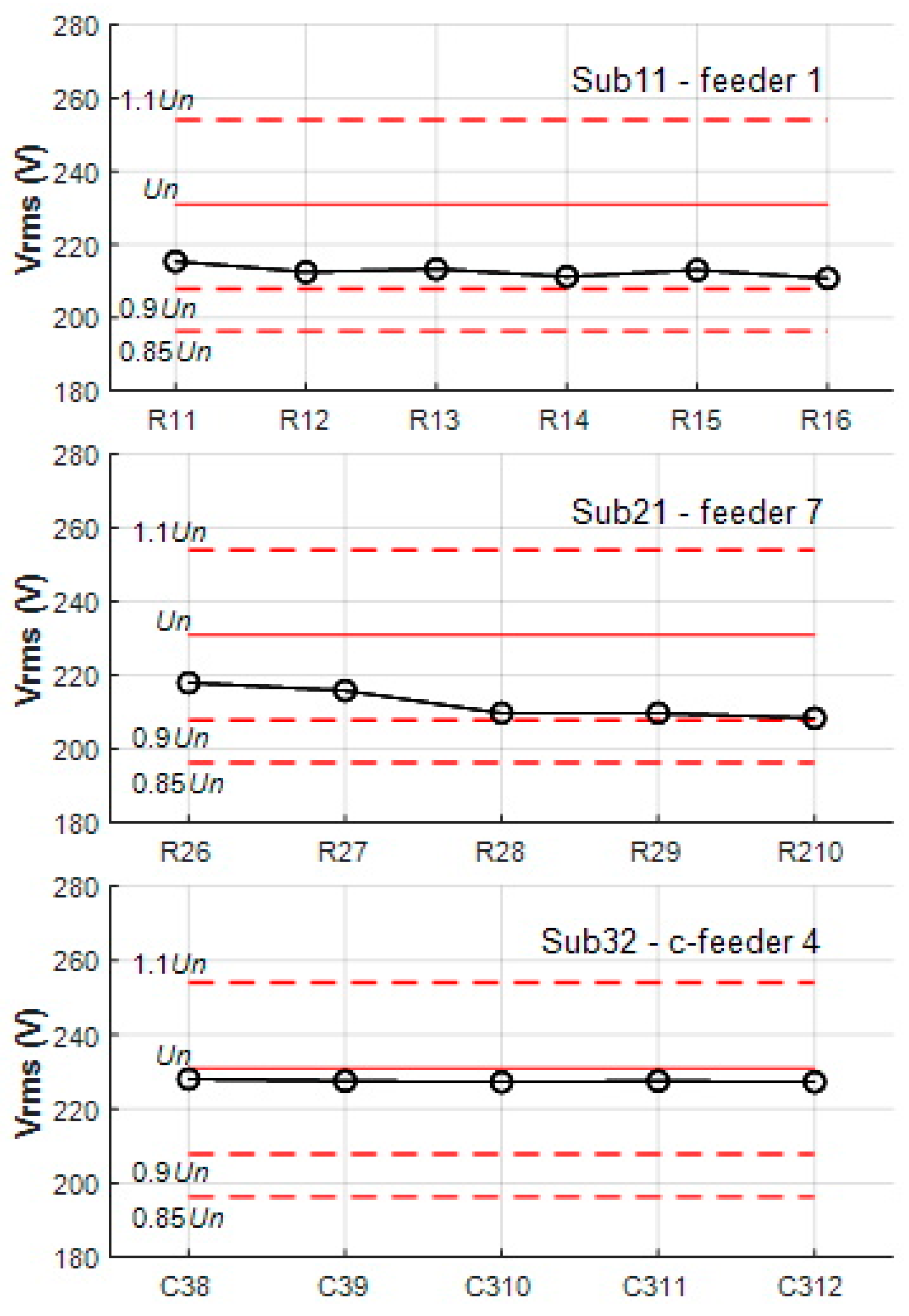

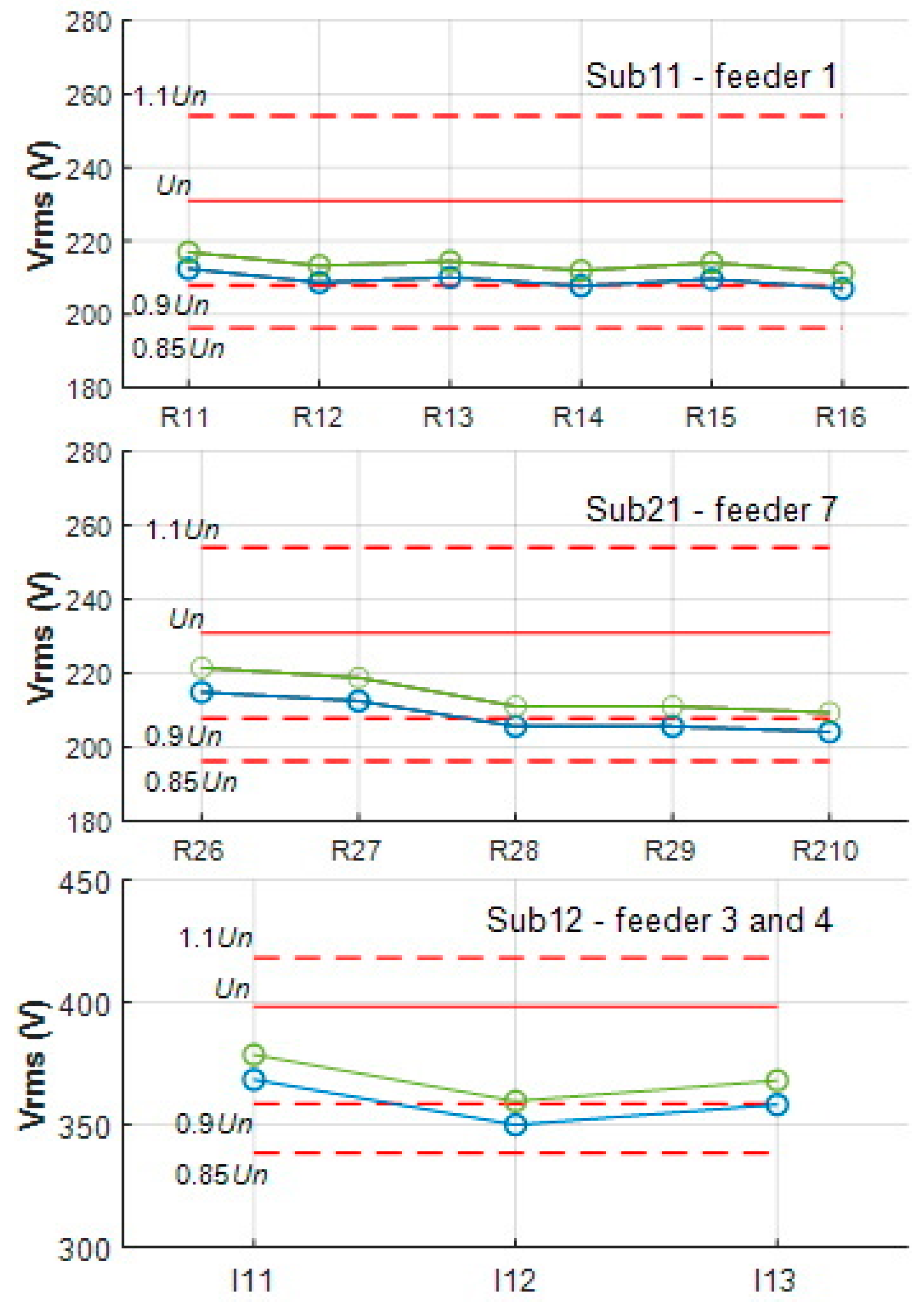


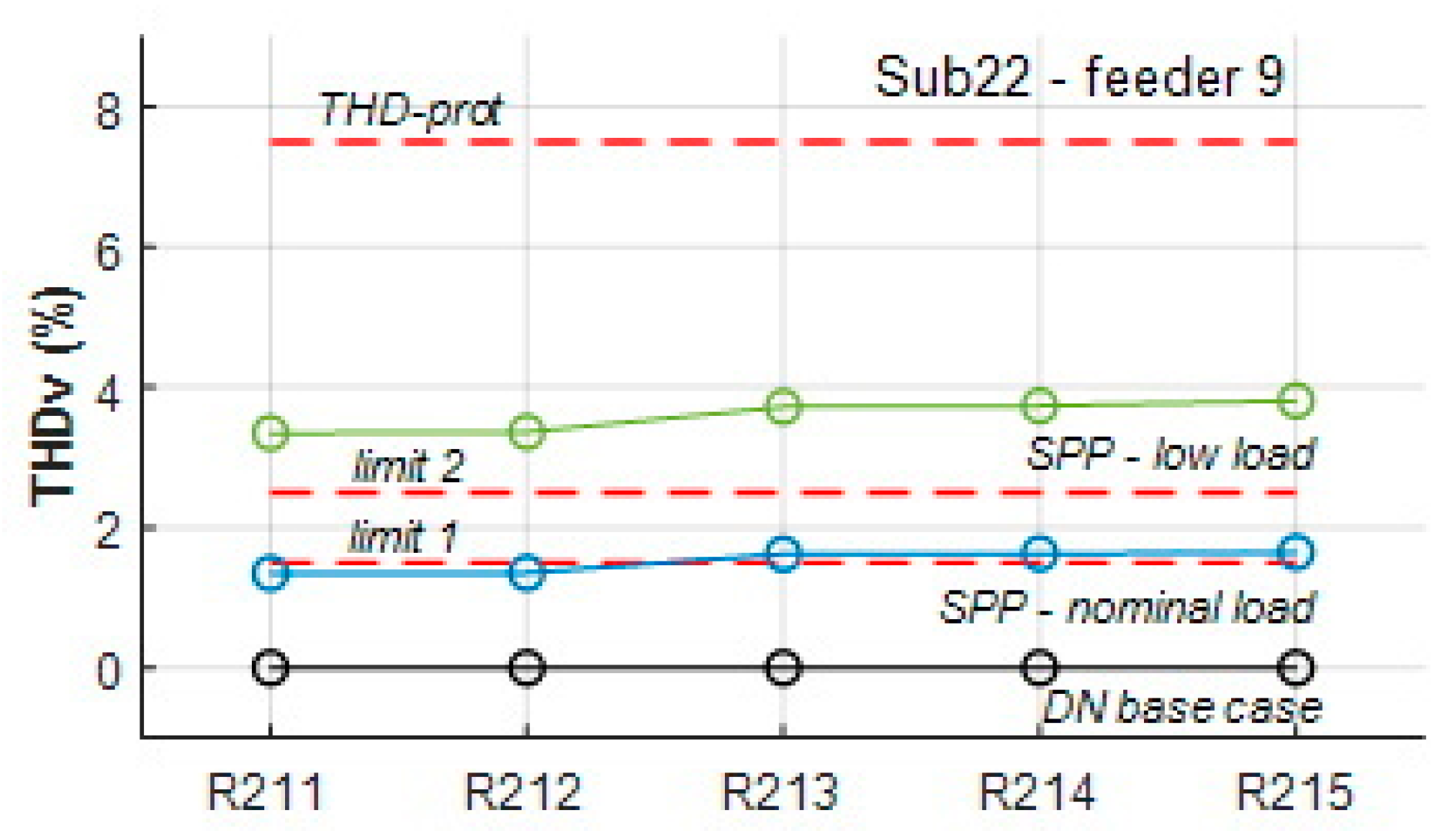

| VQ-Loading Points—LP (Low Voltage (400 V)) | ||
|---|---|---|
| Voltage RMS range | Zone rating | Recommendation |
| 0.95 Un < U < 1.05 Un | VQ-RMS LP excellent | no control action required |
| 0.9 Un < U < 0.95 Un | VQ-RMS LP good | non-urgent control action considered |
| 1.05 Un < U < 1.1 Un | VQ-RMS LP good | non-urgent control action considered |
| 0.85 Un < U < 0.9 Un | VQ-RMS LP moderate | non-urgent control action required |
| Uundervoltage-prot < U < 0.85 Un | VQ-RMS LP bad | urgent control action required |
| 1.1 Un < U < Uovervoltage-prot | VQ-RMS LP bad | urgent control action required |
| U < Uundervoltage-prot | VQ-RMS LP critical | protection action required |
| U > Uovervoltage-prot | VQ-RMS LP critical | protection action required |
| VQ-feeder zones—F (medium voltage (11 kV)) | ||
| Voltage RMS range and VQ loading point (LP) zone ratings | Zone rating | Recommendation |
| 0.95 Un < Ubusbar < 1.05 Un 80% of LP—VQ-RMS LP excellent 100% of LP—VQ-RMS LP good | VQ-RMS F excellent | no control action required |
| 0.95 Un < Ubusbar < 1.05 Un 60% of LP—VQ-RMS LP good 100% of LP—VQ-RMS LP moderate | VQ-RMS F good | non-urgent control action considered |
| 0.9 Un < Ubusbar < 1.1 Un 100% of LP—VQ-RMS LP moderate | VQ-RMS F moderate | non-urgent control action required |
| Ubus-under-prot < Ubusbar < Ubus-over-prot 100% of LP—VQ-RMS LP bad | VQ-RMS F bad | urgent control action required |
| all remaining cases | VQ-RMS F critical | urgent control/protection action required |
| VQ-MV2 zones—MV2 (medium voltage (11 kV)) | ||
| VQ-feeder (F) zone ratings | Zone rating | Recommendation |
| 80% of F—VQ-RMS F excellent 100% of F—VQ-RMS F good | VQ-RMS MV2 excellent | no control action required |
| 100% of F—VQ-RMS F good | VQ-RMS MV2 good | non-urgent control action considered |
| 100% of F—VQ-RMS F moderate | VQ-RMS MV2 moderate | non-urgent control action required |
| 100% of F—VQ-RMS F bad | VQ-RMS MV2 bad | urgent control action required |
| all remaining cases | VQ-RMS MV2 critical | urgent control/protection action required |
| VQ-MV1 zones—MV1 (medium voltage (33 kV)) | ||
| VQ-MV2 (MV2) zone ratings | Zone rating | Recommendation |
| 80% of MV2—VQ-RMS MV2 excellent 100% of MV2—VQ-RMS MV2 good | VQ-RMS MV1 excellent | no control action required |
| 100% of MV2—VQ-RMS MV2 good | VQ-RMS MV1 good | non-urgent control action considered |
| 100% of MV2—VQ-RMS MV2 moderate | VQ-RMS MV1 moderate | non-urgent control action required |
| 100% of MV2—VQ-RMS MV2 bad | VQ-RMS MV1 bad | urgent control action required |
| all remaining cases | VQ-RMS MV1 critical | urgent control/protection action required |
| VQ-Loading Points—LP (Low Voltage (400 V)) | ||
|---|---|---|
| Voltage unbalance range | Zone rating | Recommendation |
| 0% < Uunbalance < UunB-limit-1 | VQ-unB LP excellent | no control action required |
| UunB-limit-1 < Uunbalance < UunB-limit-2 | VQ-unB LP good | non-urgent control action required |
| UunB-limit-2 < Uunbalance < Uunbalance-prot | VQ-unB LP bad | urgent control action required |
| Uunbalance > Uunbalance-prot | VQ-unB LP critical | protection action required |
| VQ-feeder zones—F (medium voltage (11 kV)) | ||
| Voltage unbalance range and VQ loading point (LP) zone ratings | Zone rating | Recommendation |
| 0% < Ubus-unbalance < UunB-limit-2 80% of LP—VQ-unB LP excellent 100% of LP—VQ-unB LP good | VQ-unB F excellent | no control action required |
| 0% < Ubus-unbalance < UunB-limit-2 100% of LP—VQ-unB LP good | VQ-unB F good | non-urgent control action required |
| 0% < Ubus-unbalance < Uunbalance-prot 100% of LP—VQ-unB LP bad | VQ-unB F bad | urgent control action required |
| all remaining cases | VQ-unB F critical | urgent control/protection action required |
| VQ-MV2 zones—MV2 (medium voltage (11 kV)) | ||
| VQ-feeder (F) zone ratings | Zone rating | Recommendation |
| 80% of F—VQ-unB F excellent 100% of F—VQ-unB F good | VQ-unB MV2 excellent | no control action required |
| 100% of F—VQ-unB F good | VQ-unB MV2 good | non-urgent control action required |
| 100% of F—VQ-unB F bad | VQ-unB MV2 bad | urgent control action required |
| all remaining cases | VQ-unB MV2 critical | urgent control/protection action required |
| VQ-MV1 zones—MV1 (medium voltage (33 kV)) | ||
| VQ-MV2 (MV2) zone ratings | Zone rating | Recommendation |
| 60% of MV2—VQ-unB MV2 excellent 100% of MV2—VQ-unB MV2 good | VQ-unB MV1 excellent | no control action required |
| 100% of MV2—VQ-unB MV2 good | VQ-unB MV1 good | non-urgent control action required |
| 100% of MV2—VQ-unB MV2 bad | VQ-unB MV1 bad | urgent control action required |
| all remaining cases | VQ-unB MV1 critical | urgent control/protection action required |
| VQ-Loading Points—LP (Low Voltage (400 V)) | ||
|---|---|---|
| Voltage THD range | Zone rating | Recommendation |
| 0% < THDv < THDv-limit-1 | VQ-THD LP excellent | no control action required |
| THDv-limit-1 < THDv < THDv-limit-2 | VQ-THD LP good | non-urgent control action required |
| THDv-limit-2 < THDv < THDv-prot | VQ-THD LP bad | urgent control action required |
| THDv > THDv-prot | VQ-THD LP critical | protection action required |
| VQ-feeder zones—F (medium voltage (11 kV)) | ||
| Voltage THD range and VQ loading point (LP) zone ratings | Zone rating | Recommendation |
| 0% < THDv-bus-1 < THDv-bus-1-limit 80% of LP—VQ-THD LP excellent 100% of LP—VQ-THD LP good | VQ-THD F excellent | no control action required |
| 0% < THDv-bus-1 < THDv-bus-1-limit 100% of LP—VQ-THD LP good | VQ-THD F good | non-urgent control action required |
| 0% < THDv-bus-1 < THDv-bus-1-prot 100% of LP—VQ-THD LP bad | VQ-THD F bad | urgent control action required |
| all remaining cases | VQ-THD F critical | urgent control/protection action required |
| VQ-MV2 zones—MV2 (medium voltage (11 kV)) | ||
| Voltage THD range and VQ-feeder (F) zone ratings | Zone rating | Recommendation |
| 80% of F—VQ-THD F excellent 100% of F—VQ-THD F good | VQ-THD MV2 excellent | no control action required |
| 100% of F—VQ-THD F good | VQ-THD MV2 good | non-urgent control action required |
| 100% of F—VQ-THD F bad | VQ-THD MV2 bad | urgent control action required |
| all remaining cases | VQ-THD MV2 critical | urgent control/protection action required |
| VQ-MV1 zones—MV1 (medium voltage (33 kV)) | ||
| Voltage THD range and VQ-MV2 (MV2) zone ratings | Zone rating | Recommendation |
| 0% < THDv-bus-2 < THDv-bus-2-limit 60% of MV2—VQ-THD MV2 excellent 100% of MV2—VQ-THD MV2 good | VQ-THD MV1 excellent | no control action required |
| 0% < THDv-bus-2 < THDv-bus-2-limit 100% of MV2—VQ-THD MV2 good | VQ-THD MV1 good | non-urgent control action required |
| 0% < THDv-bus-2 < THDv-bus-2-prot 100% of MV2—VQ-THD MV2 bad | VQ-THD MV1 bad | urgent control action required |
| all remaining cases | VQ-THD MV1 critical | urgent control/protection action required |
| Voltage THD Thresholds | Load Types | ||
|---|---|---|---|
| Residential | Commercial | Industrial | |
| THDv-limit-1 | 1.5% | 2% | 3% |
| THDv-limit-2 | 2.5% | 4% | 5% |
| THDv-prot | kr1·2.5% | kc1·4% | ki1·5% |
| THDv-bus-1-limit | 2% | 3% | 4% |
| THDv-bus-1-prot | kr2·2% | kc2·3% | ki2·4% |
| THDv-bus-2-limit | 1.5% | 2% | 3% |
| THDv-bus-2-prot | kr3·1.5% | kc3·2% | ki3·3% |
| VQ-MV1 Zones | VQ-MV2 Zones | Zone Rating |
|---|---|---|
| Sub1 good | Sub11 | good |
| Sub12 | good | |
| Sub2 good | Sub21 | good |
| Sub22 | good | |
| Sub3 excellent | Sub31 | excellent |
| Sub32 | excellent |
| VQ-f Zones | VQ LP Zones | |||||
|---|---|---|---|---|---|---|
| Sub11-feeder 1 | R11 | R12 | R13 | R14 | R15 | R16 |
| good | good | good | good | good | good | good |
| Sub12-feeder 3 | I11 | I12 | / | / | / | / |
| good | excellent | good | / | / | / | / |
| Sub12-feeder 4 | I13 | / | / | / | / | / |
| good | good | / | / | / | / | / |
| Sub21-feeder 5 | R21 | R22 | / | / | / | / |
| excellent | excellent | excellent | / | / | / | / |
| Sub21-feeder 6 | R23 | R24 | R25 | / | / | / |
| good | excellent | good | good | / | / | / |
| Sub21-feeder 7 | R26 | R27 | R28 | R29 | R210 | / |
| good | good | good | good | good | good | / |
| Sub22-feeder 9 | R211 | R212 | R213 | R214 | R215 | / |
| good | good | good | good | good | good | / |
| Sub31-c-feeder 1 | R31 | R32 | R33 | / | / | / |
| excellent | excellent | excellent | excellent | / | / | / |
| Sub31-c-feeder 2 | R34 | R35 | / | / | / | / |
| excellent | excellent | excellent | / | / | / | / |
| Sub31-c-feeder 3 | R36 | R37 | / | / | / | / |
| excellent | excellent | excellent | / | / | / | / |
| Sub32-c-feeder 4 | C38 | C39 | C310 | C311 | C312 | / |
| excellent | excellent | excellent | excellent | excellent | excellent | / |
| VQ-MV1 Zones | VQ-MV2 Zones | Zone Rating |
|---|---|---|
| Sub1 ↓ moderate | Sub11 | good |
| Sub12 | ↓ moderate | |
| Sub2 ↓ moderate | Sub21 | ↓ moderate |
| Sub22 | ↓ moderate | |
| Sub3 excellent | Sub31 | excellent |
| Sub32 | excellent |
| VQ-f Zones | VQ LP Zones | |||||
|---|---|---|---|---|---|---|
| Sub11-feeder 1 | R11 | R12 | R13 | R14 | R15 | R16 |
| good | good | good | good | ↓ moderate | good | ↓ moderate |
| Sub12-feeder 3 | I11 | I12 | / | / | / | / |
| ↓ moderate | ↓ good | ↓ moderate | / | / | / | / |
| Sub12-feeder 4 | I13 | / | / | / | / | / |
| ↓ moderate | ↓ moderate | / | / | / | / | / |
| Sub21-feeder 5 | R21 | R22 | / | / | / | / |
| ↓ good | excellent | ↓ good | / | / | / | / |
| Sub21-feeder 6 | R23 | R24 | R25 | / | / | / |
| good | excellent | good | good | / | / | / |
| Sub21-feeder 7 | R26 | R27 | R28 | R29 | R210 | / |
| ↓ moderate | good | good | ↓ moderate | ↓ moderate | ↓ moderate | / |
| Sub22-feeder 9 | R211 | R212 | R213 | R214 | R215 | / |
| ↓ moderate | good | good | ↓ moderate | ↓ moderate | ↓ moderate | / |
| VQ-MV1 Zones | VQ-MV2 Zones | Zone Rating |
|---|---|---|
| Sub1 ↑ good | Sub11 | good |
| Sub12 | ↑ good | |
| Sub2 ↑ good | Sub21 | ↑ good |
| Sub22 | ↑ good | |
| Sub3 excellent | Sub31 | excellent |
| Sub32 | excellent |
| VQ-f Zones | VQ LP Zones | |||||
|---|---|---|---|---|---|---|
| Sub11-feeder 1 | R11 | R12 | R13 | R14 | R15 | R16 |
| good | good | good | good | ↑ good | good | ↑ good |
| Sub12-feeder 3 | I11 | I12 | / | / | / | / |
| ↑ good | ↑ excellent | ↑ good | / | / | / | / |
| Sub12-feeder 4 | I13 | / | / | / | / | / |
| ↑ good | ↑ good | / | / | / | / | / |
| Sub21-feeder 5 | R21 | R22 | / | / | / | / |
| ↑ excellent | excellent | ↑ excellent | / | / | / | / |
| Sub21-feeder 6 | R23 | R24 | R25 | / | / | / |
| good | excellent | ↑ excellent | good | / | / | / |
| Sub21-feeder 7 | R26 | R27 | R28 | R29 | R210 | / |
| ↑ good | ↑ excellent | good | ↑ good | ↑ good | ↑ good | / |
| Sub22-feeder 9 | R211 | R212 | R213 | R214 | R215 | / |
| ↑ good | ↑ excellent | ↑ excellent | ↑ good | ↑ good | ↑ good | / |
| VQ-MV1 Zones | VQ-MV2 Zones | Zone Rating |
|---|---|---|
| Sub1 good | Sub11 | excellent |
| Sub12 | good | |
| Sub2 ! critical | Sub21 | good |
| Sub22 | ! critical | |
| Sub3 excellent | Sub31 | excellent |
| Sub32 | excellent |
| VQ-f Zones | VQ LP Zones | |||||
|---|---|---|---|---|---|---|
| Sub11-feeder 1 | R11 | R12 | R13 | R14 | R15 | R16 |
| excellent | excellent | excellent | excellent | excellent | excellent | excellent |
| Sub12-feeder 3 | I11 | I12 | / | / | / | / |
| good | good | good | / | / | / | / |
| Sub12-feeder 4 | I13 | / | / | / | / | / |
| good | good | / | / | / | / | / |
| Sub21-feeder 5 | R21 | R22 | / | / | / | / |
| excellent | excellent | excellent | / | / | / | / |
| Sub21-feeder 6 | R23 | R24 | R25 | / | / | / |
| excellent | excellent | excellent | excellent | / | / | / |
| Sub21-feeder 7 | R26 | R27 | R28 | R29 | R210 | / |
| good | excellent | excellent | good | good | good | / |
| Sub22-feeder 9 | R211 | R212 | R213 | R214 | R215 | / |
| ! critical | bad | bad | bad | ! critical | ! critical | / |
| Simulation Case Study | VQ-f Zone | VQ LP Zones | ||||
|---|---|---|---|---|---|---|
| R211 | R212 | R213 | R214 | R215 | ||
| DN base operation case | good | good | good | good | good | good |
| SPP integration nominal feeder loading | excellent | excellent | excellent | excellent | excellent | excellent |
| SPP integration low feeder loading | excellent | excellent | excellent | excellent | excellent | excellent |
| Simulation Case Study | VQ-f Zone | VQ LP Zones | ||||
|---|---|---|---|---|---|---|
| R211 | R212 | R213 | R214 | R215 | ||
| DN base operation case | excellent | excellent | excellent | excellent | excellent | excellent |
| SPP integration nominal feeder loading | good | excellent | excellent | good | good | good |
| SPP integration low feeder loading | bad | bad | bad | bad | bad | bad |
| Nonlinear Load | Nominal Quantities | Location in DN |
|---|---|---|
| ASD1 | Pn = 200 kW, V1n = 690 V | I11 (I zone—Sub12—feeder 3) |
| ASD2 | Pn = 300 kW, V1n = 690 V | I13 (I zone—Sub12—feeder 4) |
| PC1 | Pn = 50 kW, V1n = 400 V | C39 (C zone—Sub32—c-feeder 4) |
| PC2 | Pn = 60 kW, V1n = 400 V | C310 (C zone—Sub32—c-feeder 4) |
| RAC1 | Pn = 100 kW, V1n = 400 V | R31 (R-urban zone—Sub31—c-feeder 1) |
| RAC2 | Pn = 100 kW, V1n = 400 V | R35 (R-urban zone—Sub31—c-feeder 2) |
| FL-MB1 | Pn = 100 kW, V1n = 400 V | R37 (R-urban zone—Sub31—c-feeder 3) |
| FL-EB1 | Pn = 100 kW, V1n = 400 V | C311 (C zone—Sub32—c-feeder 4) |
| VQ-MV1 Zones | VQ-MV2 Zones | Zone Rating |
|---|---|---|
| Sub1 bad | Sub11 | excellent |
| Sub12 | bad | |
| Sub2 excellent | Sub21 | excellent |
| Sub22 | excellent | |
| Sub3 bad | Sub31 | bad |
| Sub32 | bad |
| VQ-f Zones | VQ LP Zones | |||||
|---|---|---|---|---|---|---|
| Sub11-feeder 1 | R11 | R12 | R13 | R14 | R15 | R16 |
| excellent | excellent | excellent | excellent | excellent | excellent | excellent |
| Sub12-feeder 3 | I11 | I12 | / | / | / | / |
| bad | bad | bad | / | / | / | / |
| Sub12-feeder 4 | I13 | / | / | / | / | / |
| bad | good | / | / | / | / | / |
| Sub31-c-feeder 1 | R31 | R32 | R33 | / | / | / |
| bad | good | good | good | / | / | / |
| Sub31-c-feeder 2 | R34 | R35 | / | / | / | / |
| bad | good | good | / | / | / | / |
| Sub31-c-feeder 3 | R36 | R37 | / | / | / | / |
| bad | good | good | / | / | / | / |
| Sub32-c-feeder 4 | C38 | C39 | C310 | C311 | C312 | / |
| bad | good | bad | bad | good | good | / |
Disclaimer/Publisher’s Note: The statements, opinions and data contained in all publications are solely those of the individual author(s) and contributor(s) and not of MDPI and/or the editor(s). MDPI and/or the editor(s) disclaim responsibility for any injury to people or property resulting from any ideas, methods, instructions or products referred to in the content. |
© 2024 by the authors. Licensee MDPI, Basel, Switzerland. This article is an open access article distributed under the terms and conditions of the Creative Commons Attribution (CC BY) license (https://creativecommons.org/licenses/by/4.0/).
Share and Cite
Forcan, M.; Simović, A.; Jokić, S.; Forcan, J. A Zonal Approach for Wide-Area Temporary Voltage Quality Assessment in a Smart Grid. Energies 2024, 17, 2475. https://doi.org/10.3390/en17112475
Forcan M, Simović A, Jokić S, Forcan J. A Zonal Approach for Wide-Area Temporary Voltage Quality Assessment in a Smart Grid. Energies. 2024; 17(11):2475. https://doi.org/10.3390/en17112475
Chicago/Turabian StyleForcan, Miodrag, Aleksandar Simović, Srđan Jokić, and Jovana Forcan. 2024. "A Zonal Approach for Wide-Area Temporary Voltage Quality Assessment in a Smart Grid" Energies 17, no. 11: 2475. https://doi.org/10.3390/en17112475






